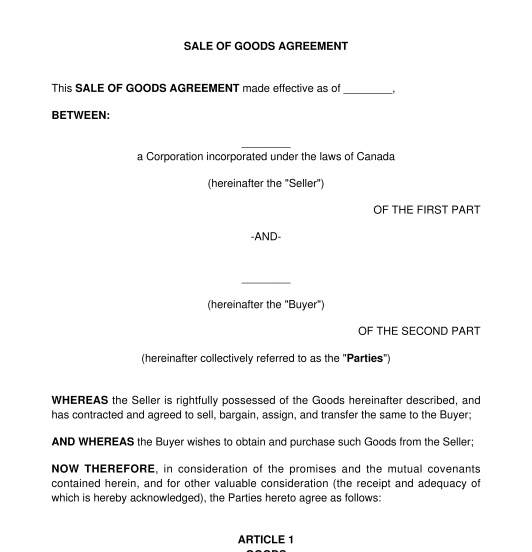 10/09/2025
10/09/2025

Answer a few questions and your document is created automatically.

Your document is ready! You will receive it in Word and PDF formats. You will be able to modify it.

 10/09/2025
10/09/2025
 Word and PDF
Word and PDF
 6 to 8 pages
6 to 8 pages
A Sale of Goods Agreement is a contract in which the Seller transfers property to the Buyer in exchange for money. Sale of Goods Agreements can be used by commercial parties or by consumers. They are most frequently used between commercial parties (businesses). For example, one business can purchase manufacturing parts from another business. However, the agreement can be used for consumer purposes where the Seller supplies goods to a consumer (someone buying in a personal capacity). For example, a consumer may purchase horse grain mix from a Seller to feed their horses.
The contract should cover whether the goods are:
The document should also cover the type of goods being sold, the purchase price, when ownership will transfer, and how delivery will take place.
The agreement is a written document covering the Buyer and Seller's intentions. The parties can be individuals or businesses, and the agreement can be for one or multiple goods, which means the Seller and Buyer can agree to the purchase of a single good or multiple goods that can be delivered on different dates.
The property must be personal property, such as movable items including vehicles, clothing, food, furniture, etc. and not:
The primary difference between a Merchandise Distribution Agreement and a Sale of Goods Agreement is that in a Merchandise Distribution Agreement, the distributor is an intermediary between a supplier and end customer or retailer. On the other hand, in a Sale of Goods Agreement, the seller directly sells to the purchaser who receives ownership to the goods. In a Merchandise Distribution Agreement, ownership may still rest with the supplier until such goods are sold to the end-user.
The seller and buyer signing the agreement may be:
The signatories to the contract must be at least majority age and not under a disability. The ages of majority are as follows:
The duration of a sale of goods agreement may vary. The duration can be open-ended with the parties agreeing on when to terminate or cancel their agreement. The agreement can also be for a fixed-term such as 5 years or until a certain event has been satisfied. The duration of the contract is flexible and is based on the parties' needs.
After the document is complete, the Seller and the Buyer must sign and date the agreement. Each party needs to keep a signed copy for their records. The parties must then make arrangements for delivery and insurance if agreed to in the contract.
Sale of Goods Agreements are governed by specific statutes including consumer protection law, antitrust law, and potentially intellectual property and franchise law. Some pieces of legislation on consumer protection include the following:
Ontario: Consumer Protection Act, 2002, S.O. 2002, c. 30, Sched. A and the Sale of Goods Act, R.S.O. 1990, c. S.1
Alberta: Consumer Protection Act, RSA 2000, c C-26.3 and the Sale of Goods Act, RSA 2000, c S-2
British Columbia: Business Practices and Consumer Protection Act, SBC 2004, c 2 and the Sale of Goods Act, RSBC 1996, c 410
Manitoba: Consumer Protection Act, CCSM c C200 and The Sale of Goods Act, CCSM c S10
Saskatchewan: The Consumer Protection and Business Practices Act, SS 2013, c C-30.2 and The Sale of Goods Act, RSS 1978, c S-1
Quebec: Consumer Protection Act, CQLR c P-40.1
New Brunswick: Consumer Product Warranty and Liability Act, SNB 1978, c C-18.1 and the Sale of Goods Act, RSNB 2016, c 110
Nova Scotia: Consumer Protection Act, RSNS 1989, c 92 and the Sale of Goods Act, RSNS 1989, c 408
Prince Edward Island: Consumer Protection Act, RSPEI 1988, c C-19 and the Sale of Goods Act, RSPEI 1988, c S-1
Yukon: Consumers Protection Act, RSY 2002, c 40 and the Sale of Goods Act, RSY 2002, c 198
Nunavut: Consumer Protection Act, RSNWT (Nu) 1988, c C-17 and the Sale of Goods Act, RSNWT (Nu) 1988, c S-2
Northwest Territories: Consumer Protection Act, RSNWT 1988, c C-17 and the Sale of Goods Act, RSNWT 1988, c S-2
Newfoundland and Labrador: Consumer Protection and Business Practices Act, SNL 2009, c C-31.1 and the Sale of Goods Act, RSNL 1990, c S-6
If the commercial parties are dealing with each other on an international level and are part of a treaty country under the United Nations Convention on Contracts for the International Sale of Goods, each Province and Territory will have an international sale of goods law. A typical example of two treaty countries dealing with each other includes the United States and Canada. The international sale of goods law can be excluded by contract.
You fill out a form. The document is created before your eyes as you respond to the questions.
At the end, you receive it in Word and PDF formats. You can modify it and reuse it.
Sale of Goods Agreement - Template - Word & PDF
Country: Canada (English)